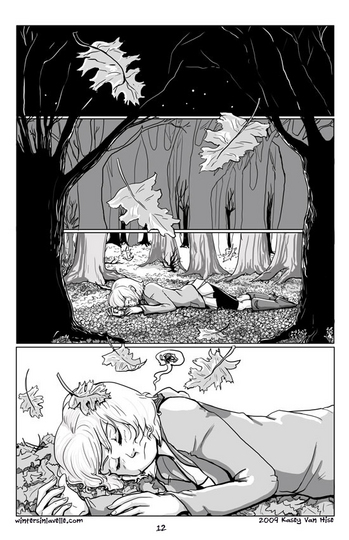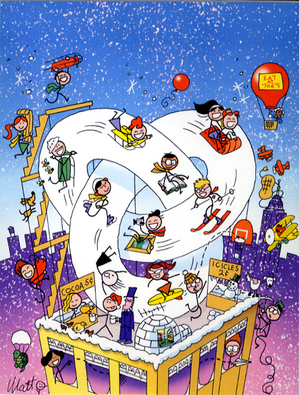River Gallery exhibit displays process, potential of comic art

Untitled comic by Kasey Van Hise
Oh, yes they are. The talents comprising this lively invitational exhibition of original comic book art are Brandon Dayton, Anne Drozd, Jerzy Drozd, Luis Escobar, Matt Feazell, Jannie Ho, Kim Holm, Dave Roman, Raina Telgemeier, and Kasey Van Hise. Among them are multiple prize-winners as well as illustrators for ancillary entertainments as diverse as Walt Disney productions and “The Simpsons” television series.
As such, the exhibit—comfortably wrapping itself around the spacious River Gallery first floor gallery as one of a number of programs taking place in Chelsea for that city’s District Library and Center for the Arts-sponsored “Kids Read Comics” event—runs from kid-friendly art to adult-oriented comics. Each talent here is a master. Although the art varies widely, all the artists share a dedication to this remarkable form.
The history of the “comic” goes back to the advent of movable type in the 15th century, and it’s undergone as many permutations as has type itself. Ranging from William Hogarth’s biting 18th century socially conscious print observations to today’s alternative comix format—and ranging from newspaper comic strips to graphic novels—the only sure thing about comic art is that it will continue to change.
Formally, the format is characterized by a series of tight-knit verbal and visual elements typically set side by side in panels to communicate a narrative. But even this expansive definition is flexible enough to encompass picture-only graphics as well as visual imagery that functions in counterpoint to the narrative.
“There are two challenges in creating a gallery exhibition of comic art,” says exhibit curator Jerzy Drozd. “The first is to find a means of accurately representing the narrative power of the medium while displaying only a portion of a comic story. The second is to demonstrate the incredible variety of expressive styles to be found within the medium.
“With regard to the first challenge, our artists submitted doodles, notes, and sketches that led to the completed piece on display. In this way we found a new narrative in displaying comics work. The public is invited to read the mind of the cartoonist as they navigate the decision-making process of creating a comics story.”
This schematic approach (which varies greatly from artist to artist) defines “Comic Jam!” From rough drafts to finished product, what separates the display from mere illustration is its scope of finished artistry. For not only are such samples mounted for inspection, but there are many examples of periodicals intermingled with these drafts, alongside the often multicolored finished drawings.
The artists' personalities shine through their work—and their accompanying gallery statements often reflect a puckish view of what they are doing. Sensibility is everything here, and it's a marvel to this many different artistic temperaments in a single setting.
“You see,” says “Simpsons” illustrator Luis Escobar in his gallery statement, “comics are a special medium. They incorporate many of the skills needed in good literature, as well as all the skill one needs in good art.
“You need to know good story structure, natural dialogue writing, as well as saying something with your story, on top of good visual design, composition, perspective, anatomy, color theory, symbolism, and personal expression.”
These qualities easily fit Norwegian cartoonist Kim Holm’s contribution. A sample drawn from his interpretation of H.P. Lovecraft’s 1926 “Pickman’s Model” short story gives us a glimpse of the challenges facing comic artists. He shows us drawings of three separate panels as well as the finished composite that the public would ultimately see. “The first two sheets show the subtle brushwork making the digitized photographs come alive,” says Holm, “while the third, showing the protagonist and antagonist in the backstreets of Boston’s North End, hints at a reality that can only be achieved by artistic exaggeration and simplification. Holm’s works are superior examples of comic art’s ability to transmit mystery and mood through color and form.

"Comic Zone" by Matt Feazell
Feazell, a Hamtramck-based comics artist works primarily in small press minicomics, is best known for his “The Amazing Cynicalman” comic series whose defining stylistic characteristic is the “stick figure” he uses to humorous effect.
He’s also a contributor to Disney’s “Comic Zone,” and here we can see the transition from freehand idea through framed final composition. The precision of Feazell’s line is the crucial element of the drawing version; while his addition of color adds an animating dimension to the final version of that page. Each step is a fully articulated artwork—even if their differing moods are undeniable. It’s just good to see a gifted artist kicking out a jubilant “comic jam” in his chosen art.
“Comic Jam!” will continue through June 23 at the River Gallery, 120 S. Main St., Chelsea. The exhibit is part of a Kids Read Comics celebration in Chelsea on June 18-19. Gallery hours are 11 a.m. to 5 p.m., Tuesday-Friday; and 11 a.m. to 8 p.m., Saturday. For information, call 734-433-0826.

